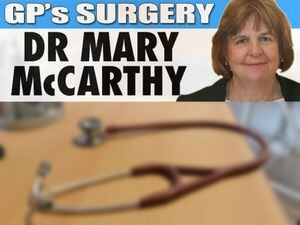Dr Mary McCarthy: We must be sensible with painkillers
Pain is a warning system. It signals to the body that something is wrong, where it is wrong and, roughly, how bad it is.

It is extremely useful mechanism of the human body designed to make you stop doing whatever it is that could potentially make the pain worse
If you fall and break a bone, it encourages you applying pressure on the bone keeping the bone stable with the gradual reduction in pain letting you know the bone is healing. With sprains or muscle strains the principal is the same. As the lesion heals so the pain lessens and movement improves.
Abdominal pain can tell us by its nature, whether intermittent or constant, whether griping or chronic, which organ or system is the likely culprit. Infection is signalled not just by pain, but by swelling, redness and heat. The goes as far back as roman times where physicians recognised this set of symptoms by the Latin phrase, dolor, tumor, rubor, calor.
There are however some sources of pain that are do not improve as easily and this is when drugs known as painkillers can be extremely useful. Joints and the spine can accumulate damage over the years and until we can provide people with a new skeleton, the best we can do is use pain killers appropriately and, where possible, use physiotherapy to increase muscle mass in order to support bone structures.
The impact of this “wear and tear” effect on the spine and on joints is so debilitating that patient are often unable to pursue a normal lifestyle.
Pain caused by cancer is also not going to be cured by time and the spread of cancer from the primary site into the bones can be especially difficult to treat.
There are Pain Clinics, run by anaesthetists, that offer advice on pain control but for some intractable pain the only drug that works well is again a drug that was known about in olden times.
Opium, derived from poppies, was used as pain relief for thousands of years and opiate derivatives are still the basis of most severe pain relief medications.
Morphine for example will provide instant and effective pain relief but, like any effective drug, comes with side effects.
As with other opiates, it can cause constipation which can be as distressing for the patient as the original pain. It can make the patient feel sleepy and slightly muddled. These side effects are often more acceptable, to the patient if not to their immediate family and the dose can be gradually increased until the pain is relieved or the side effects become too much for the patient to cope with.
Laudanum, a tincture of opium, was used by Queen Victoria when she was in childbirth and was freely available in Victorian England.
There are many medications that contain small amounts of opiates like codeine. Again, these are very useful for what is hopefully going to be short-term pain relief. The problem, as with all these drugs, is that they are also addictive and patients can grow dependent on them, and not for just for their pain reliving qualities.
Lat year, the BMA published a set of recommendations after working with prescription addiction help groups and medical groups to improve support for people suffering prescription drug dependence which included a 24 hour helpline for prescribed drug dependence.
The current opioid epidemic in the states is an example of how opiate addiction can spiral out of control with those who developed a dependency on prescription opiates moving on to heroin.
Codeine, especially, is becoming a problem and can be difficult to deal with owing to their accessibility. We need to be sensible about the use of painkillers. They are useful drugs for acute pain relief but when used over the long-term, they require close supervision and adequate support for patients who find themselves growing dependent on them.
* Dr Mary McCarthy has worked at Belvidere Surgery in Shrewsbury for more than 20 years. She is chairman of the local medical committee and represents Shropshire, North Staffordshire and South Staffordshire on the General Practitioners Committee of the BMA.





